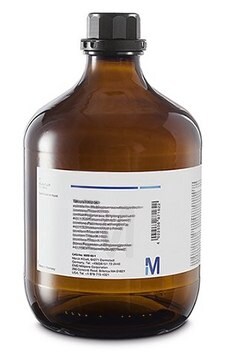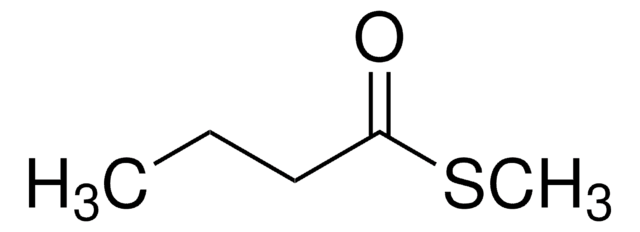W279900
Octanoic acid
≥98%, FG
Synonym(s):
Acid C8, Caprylic acid
About This Item
biological source
synthetic
Quality Level
grade
FG
Fragrance grade
Halal
Kosher
Agency
follows IFRA guidelines
meets purity specifications of JECFA
reg. compliance
EU Regulation 1223/2009
EU Regulation 1334/2008 & 178/2002
FDA 21 CFR 172.210
FDA 21 CFR 172.860
FDA 21 CFR 184.1025
vapor density
5 (vs air)
vapor pressure
1 mmHg ( 78 °C)
Assay
≥98%
refractive index
n20/D 1.428 (lit.)
bp
237 °C (lit.)
mp
15-17 °C (lit.)
density
0.91 g/mL at 25 °C (lit.)
application(s)
flavors and fragrances
Documentation
see Safety & Documentation for available documents
food allergen
no known allergens
fragrance allergen
no known allergens
Organoleptic
fatty; oily; vegetable; waxy; cheesy; rancid
SMILES string
CCCCCCCC(O)=O
InChI
1S/C8H16O2/c1-2-3-4-5-6-7-8(9)10/h2-7H2,1H3,(H,9,10)
InChI key
WWZKQHOCKIZLMA-UHFFFAOYSA-N
Looking for similar products? Visit Product Comparison Guide
General description
Application
- Chemical Characterization of Terpene-Based Hydrophobic Eutectic Solvents and Their Application for Pb(II) Complexation during Solvent Extraction Procedure.: Research investigates the use of octanoic acid in the synthesis of novel terpene-based eutectic solvents, focusing on their application in heavy metal extraction. This study is crucial for environmental chemistry, offering a sustainable alternative for pollutant removal (Suljkanović et al., 2024).
- Green and Efficient Extraction of Phenolic Components from Plants with Supramolecular Solvents: Experimental and Theoretical Studies.: This research utilizes octanoic acid in the development of supramolecular solvents for the extraction of phenolic compounds from plants. The study focuses on optimizing extraction efficiency and sustainability, enhancing the production of natural antioxidants (Xia et al., 2024).
Signal Word
Danger
Hazard Statements
Precautionary Statements
Hazard Classifications
Aquatic Chronic 3 - Eye Dam. 1 - Skin Corr. 1C
Storage Class Code
8A - Combustible corrosive hazardous materials
WGK
WGK 1
Flash Point(F)
>230.0 °F - closed cup
Flash Point(C)
> 110 °C - closed cup
Personal Protective Equipment
Certificates of Analysis (COA)
Search for Certificates of Analysis (COA) by entering the products Lot/Batch Number. Lot and Batch Numbers can be found on a product’s label following the words ‘Lot’ or ‘Batch’.
Already Own This Product?
Find documentation for the products that you have recently purchased in the Document Library.
Customers Also Viewed
Our team of scientists has experience in all areas of research including Life Science, Material Science, Chemical Synthesis, Chromatography, Analytical and many others.
Contact Technical Service






